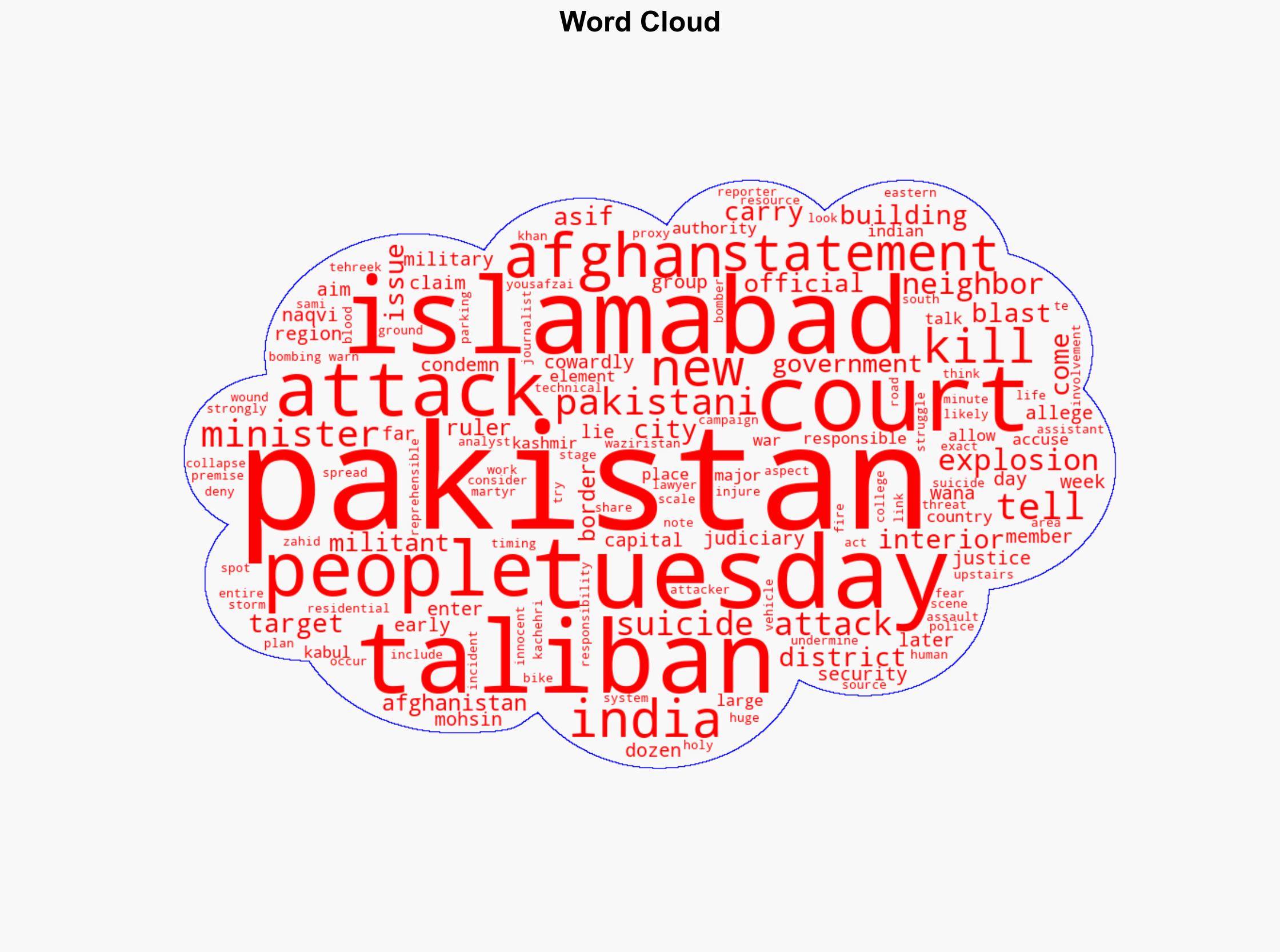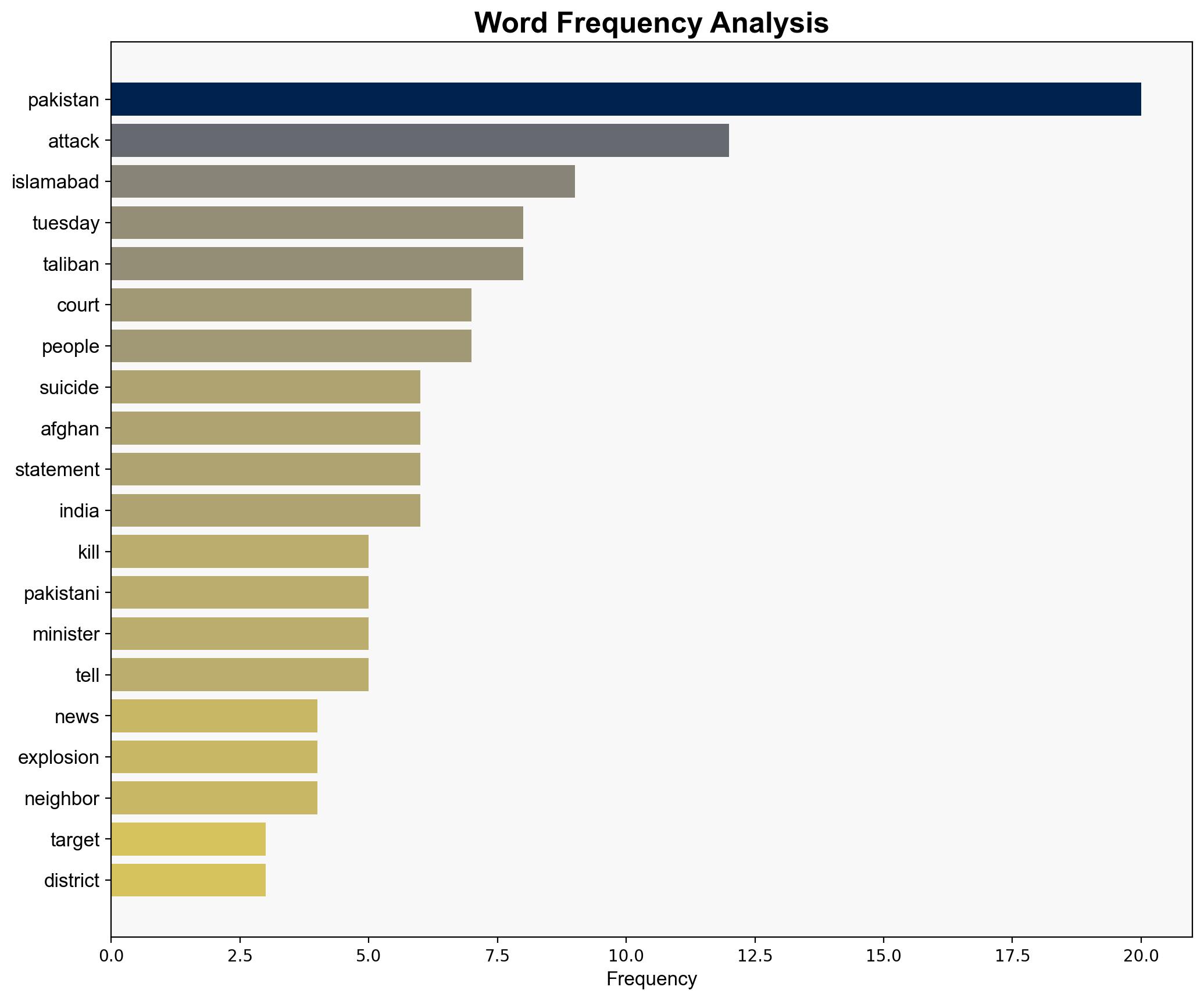Pakistan blames India Afghanistan as blast near court kills at least 12 – CBS News
Published on: 2025-11-11
AI-powered OSINT brief from verified open sources. Automated NLP signal extraction with human verification. See our Methodology and Why WorldWideWatchers.
Intelligence Report: Pakistan blames India Afghanistan as blast near court kills at least 12 – CBS News
1. BLUF (Bottom Line Up Front)
With moderate confidence, the most supported hypothesis is that the attack was orchestrated by Tehreek-e-Taliban Pakistan (TTP) to destabilize Pakistan’s judicial system and governance. Strategic recommendations include enhancing intelligence cooperation with regional partners and reinforcing security protocols around critical infrastructure.
2. Competing Hypotheses
Hypothesis 1: The attack was conducted by Tehreek-e-Taliban Pakistan (TTP) as part of a broader campaign against the Pakistani state.
- Supporting Evidence: TTP has claimed responsibility for the attack, aligning with their historical modus operandi of targeting state institutions.
- Counter Evidence: TTP’s denial of involvement in a recent attack in Wana suggests possible disinformation tactics or factional splits within the group.
Hypothesis 2: The attack was facilitated by Indian-backed elements or Afghan Taliban proxies to destabilize Pakistan.
- Supporting Evidence: Pakistan’s Interior Minister alleged involvement of Indian-backed elements, consistent with historical accusations of Indian interference.
- Counter Evidence: The Indian government has categorically denied these allegations, and no independent verification supports the claim.
3. Key Assumptions and Red Flags
Assumptions: It is assumed that TTP’s claim of responsibility is credible. The Pakistani government’s allegations against India and Afghan Taliban proxies are based on intelligence assessments.
Red Flags: The timing of the attack coinciding with failed negotiations between Pakistan and the Afghan Taliban raises suspicion of potential manipulation or exploitation of the situation by external actors.
Deception Indicators: TTP’s conflicting statements regarding their involvement in recent attacks may indicate internal discord or strategic deception.
4. Implications and Strategic Risks
The attack exacerbates existing tensions between Pakistan, India, and Afghanistan, potentially leading to increased military posturing and diplomatic friction. There is a risk of retaliatory actions, both kinetic and cyber, that could destabilize the region further. The attack also threatens to undermine public confidence in Pakistan’s judicial and security apparatus, potentially leading to domestic unrest.
5. Recommendations and Outlook
- Actionable Steps: Enhance intelligence-sharing mechanisms with regional partners, particularly focusing on counter-terrorism efforts. Strengthen security measures around judicial and governmental buildings.
- Best Scenario: Increased regional cooperation leads to effective counter-terrorism operations, reducing the threat of future attacks.
- Worst Scenario: Escalation of cross-border tensions results in military confrontations, further destabilizing the region.
- Most-likely Scenario: Continued low-intensity conflict with sporadic attacks by militant groups, maintaining regional instability.
6. Key Individuals and Entities
Mohsin Naqvi (Pakistan Interior Minister), Khawaja Asif (Pakistan Minister of Defense), Shri Randhir Jaiswal (Indian Government Spokesperson), Tehreek-e-Taliban Pakistan (TTP).
7. Thematic Tags
Counter-Terrorism
Structured Analytic Techniques Applied
- ACH 2.0: Reconstruct likely threat actor intentions via hypothesis testing and structured refutation.
- Indicators Development: Track radicalization signals and propaganda patterns to anticipate operational planning.
- Narrative Pattern Analysis: Analyze spread/adaptation of ideological narratives for recruitment/incitement signals.
Explore more:
Counter-Terrorism Briefs ·
Daily Summary ·
Methodology





